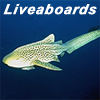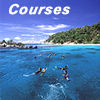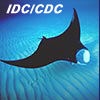Reef Ecology Guide Phuket Thailand - Bony Fishes 5
GOBIES (Gobiidae)

The largest family of marine fishes, comprising over 200 genera and an estimated 1500 species world wide. The majority of species are tropical and live on reefs or nearby on sand. Many of the sand gobies bury in the sand at night, others use burrows.
Because of their small size and secretive habits, many new species are being discovered, especially in the south-east Asian region, and the total number of species is even difficult to guess at this stage.
Many species are highly specialized and associate with various invertebrates, ranging from certain coral species and sponges to specific crustaceans.
Most gobies pair to breed and use burrows, narrow ledges and empty shells for nesting sites, producing hundreds of sticky eggs. The male or both sexes guard the eggs. Hatching larvae are attracted by light and swim quickly to the surface.
GREEN PYGMY GOBY (Eviota guttata)
 Length: to 2,5 cm
Length: to 2,5 cm
Common in shallow water around the Similan Islands in diverse mixed rubble, coral and algae reef habitats.
Distinct by large red blotches and a greenish sheen. Feeds on zooplankton.
CARDINALFISHES (Apogonidae)

A very large family of small reef fishes, most numerous in tropical waters. The majority of species live in shallow coastal waters, occupying caves and crevices during the day and drifting out in the open during the night to feed. Their diet consists of small planktonic invertebrates but a few also feed on small fishes.
They typically have 2 spines in the anal fin and 2 usually separate dorsal fins. The reef dwellers are distinctly marked with stripes and spots. Cardinal fishes are one of the few marine fish families which use oral brooding. After fertilization the male takes the eggs in the mouth for incubation which lasts just over one week.
Apart from brooding males the sexes are very similar. In some species the females are larger and more colorful, particularly during courtship, in which she dominates.
TIGER-CARDINALFISH (Apogon lineatus)
 Length: to 25 cm
Length: to 25 cm
Inhabit coastal reefs and rocky estuaries. A widespread, large species with powerful jaws and strong teeth, feeding on fishes and crustaceans.
FUSILIERS (Caesionidae)

A small, tropical family, closely related to Snappers. Fusiliers are schooling, planktivorous, small fishes with streamlined bodies.
On the reefs these fishes have ornamental value with their bright colors, mostly yellow and blue. Large schools commonly patrol the slopes and walls in pursuit of zooplankton. By night, they change color and hide in caves and crevices in the coral reef.
GOATFISHES (Mullidae)

A widespread family of bottom dwelling fishes, living on sandy flats or coral rubble. An easily identified family by the presence of a pair of barbels on the chin.
Many are bright red all over or with broad bands. Sometimes these colors show during the day when resting on the substrate or when visiting cleaning stations to highlight the presence of parasites.
Goatfishes use their strong barbels to dig and sense prey in the substrate. Their diet consists of crustaceans, invertebrates and small fish. Often they are accompanied by unrelated species such as wrasses, which keep an eye on the work of the goatfish in case something tasty appears.
SOLDIERFISHES (Holocentridae)

A large, globally distributed tropical family with about 70 species, mostly of red coloration.
They are nocturnal, by day commonly seen in caves or under large overhangs along drop-offs. They are secretive, occurring singly or schooling in caves. At night they hunt for shrimps or large zooplankton and swim individually over reefs or sand.
All species have in common a deep forked caudal fin, big eyes, an elastic mouth and large scales. Also includes Squirrel fishes (Holocentrinae), which have a prominent spine on the lower corner of the gill cover, which is thought to be venomous in some species.
REDCOAT SQUIRRELFISH (Sargocentron rubrum)
 Length: to 27 cm
Length: to 27 cm
Inhabits coastal reefs and large lagoons. Usually at moderate depths in small to large aggregations.
WRASSES (Labridae)

The wrasses make up one of the largest families of fishes on tropical reefs worldwide. It comprises more than 60 genera and an estimated 400 species.
Wrasses are highly diverse in shape and range greatly in size. They can be recognized by their thick lips and a tight mouth opening. Normally juveniles become females first and males derive from females.
In almost all species the fully developed males become very colorful and can look totally different from the earlier stages. Most males dominate a number of females and are territorial towards other males.
Wrasses feed on a great variety of invertebrates and small fishes. A few are specialized feeders, taking plankton or picking parasites from other fishes. Wrasses are active at day and retire by either burying in the sand or by wedging themselves into crevices.
CLEANER WRASSE (Labroides dimidiatus)
 Length: to 10 cm
Length: to 10 cm
Most abundant cleaner fish. A pattern of longitudinal stripes clearly identifies cleaner wrasses to host fishes.
It even swims into the wide opened mouth of large groupers to clean their teeth. Great to watch at a cleaning staion during dives in the Similan Islands or around Phuket.
NAPOLEON (Cheilinus undulatus)
Length: to 2,3 m
The napoleon is the largest and heaviest of all wrasses. This species can reach up to 150 kg, feeding mainly on molluscs.
Adults can be easily recognized by their large size and the hump on the forehead. They are not shy towards divers.
Dive Asia - Phuket Thailand
Office Address: 8/30 Soi Yodsanee, Chalong, Phuket 83150, Thailand
Phone: +66 (0) 818948588 or 0899736005
Visit us at one of our Offices: (Google Map)
Email:
Website: www.diveasia.com
24 Hour Hotline: +66 (0) 818948588








 Length: to 11 cm
Length: to 11 cm Length: to 24 cm
Length: to 24 cm Length: to 55 cm
Length: to 55 cm








